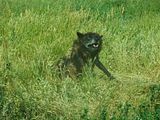Bigfoot Discussion
Moderator: Kenya
-
Alpha Ridley
- Adult Mouse
- Posts: 744
- Joined: Sun Apr 17, 2011 1:06 pm
Bigfoot Discussion
Bigfoot, the bipedal primate that roams the world with many names. There have been many sightings of this animal, even though it is still a hidden animal. I think it is real. But do YOU believe in Bigfoot?
Please join my Okavango Delta RP!
- oceanpelt
- Bluebird Chick
- Posts: 54
- Joined: Wed Apr 04, 2012 10:12 pm
- Location: He's the map, he's the map, he's the map! Yeah, I am lost.
- Contact:
Re: Bigfoot Discussion
Not really, I think 'Bigfoot' is really a large monkey, or a bear. Something more sensible, the sightings may be just people dressing up for publicity.

-
Alpha Ridley
- Adult Mouse
- Posts: 744
- Joined: Sun Apr 17, 2011 1:06 pm
Re: Bigfoot Discussion
But the first Bigfoot video was filmed before suits were made.
Please join my Okavango Delta RP!
-
animalguy888
- Adult Gecko
- Posts: 1546
- Joined: Thu Apr 07, 2011 10:42 am
- Location: In the sky hunting for a hybrid between superman and bigfoot in an alternate universe
- Contact:
Re: Bigfoot Discussion
I believe in UFOS,Sasquach aka bigfoot,and the lochness monster. Im not crazy or anything though. While a lot of people claim thiier not real. These top 3 mysterous creature have been recorded sinse anctcaint times. IM pretty sure the natives that ocassionay saw things such as bigfoot befor america was created did not have big suits. Neither did the mayans or atecs which have been seen with alien like being recorded into their culture and other evidense as well.loch ness monsters sigtings go back to the 6th century.
heres an article i just found on bigfoot.
heres an article i just found on bigfoot.
Bigfoot, also known as sasquatch, is an ape-like cryptid that purportedly inhabits forests, mainly in the Pacific Northwest region of North America. Bigfoot is usually described as a large, hairy, bipedal humanoid. The term "sasquatch" is an anglicized derivative of the Halkomelem word sásq’ets.[2][3]
Bigfoot is described in reports as a large hairy ape-like creature, in a range of 6–10 feet (2–3 m) tall, weighing in excess of 500 pounds (230 kg), and covered in dark brown or dark reddish hair.[5][9] Alleged witnesses have described large eyes, a pronounced brow ridge, and a large, low-set forehead; the top of the head has been described as rounded and crested, similar to the sagittal crest of the male gorilla. Bigfoot is commonly reported to have a strong, unpleasant smell by those who claim to have encountered it.[10] The enormous footprints for which it is named have been as large as 24 inches (60 cm) long and 8 inches (20 cm) wide.[9] While most casts have five toes — like all known apes — some casts of alleged bigfoot tracks have had numbers ranging from two to six.[11] Some have also contained claw marks, making it likely that a portion came from known animals such as bears, which have five toes and claws.[12][13] Some proponents have also claimed that bigfoot is omnivorous and mainly nocturnal.[14]Scientists discount the existence of bigfoot and consider it to be a combination of folklore, misidentification, and hoax,[4] rather than a living animal, in part because of the large numbers thought necessary to maintain a breeding population.[5][6] A few scientists, such as Jane Goodall[7] and Jeffrey Meldrum, have expressed interest and belief in the creature, with Meldrum expressing the opinion that evidence collected of alleged Bigfoot encounters warrants further evaluation and testing.[8] Bigfoot remains one of the more famous examples of a cryptid within cryptozoology, and an enduring legend.
It seems the orginal natives of north america also have had bigfoot sightings and storys. If people witness criptids and alians before there was our computers and other things that can edit it into a hoax then does that meat at least some of it is true and real. I think yes.Wildmen stories are found among the indigenous population of the Pacific Northwest. The legends existed prior to a single name for the creature.[15] They differed in their details both regionally and between families in the same community. Similar stories of wildmen are found on every continent except Antarctica.[15] Ecologist Robert Michael Pyle argues that most cultures have human-like giants in their folk history: "We have this need for some larger-than-life creature."[16]
Members of the Lummi tell tales about Ts'emekwes, the local version of bigfoot. The stories are similar to each other in terms of the general descriptions of Ts'emekwes, but details about the creature's diet and activities differed between the stories of different families.[17]
Some regional versions contained more nefarious creatures. The stiyaha or kwi-kwiyai were a nocturnal race that children were told not to say the names of lest the monsters hear and come to carry off a person—sometimes to be killed.[18] In 1847, Paul Kane reported stories by the native people about skoocooms: a race of cannibalistic wild men living on the peak of Mount St. Helens.[12] The skoocooms appear to have been regarded as supernatural, rather than natural.[12]
Less menacing versions such as the one recorded by Reverend Elkanah Walker exist. In 1840, Walker, a Protestant missionary, recorded stories of giants among the Native Americans living in Spokane, Washington. The Indians claimed that these giants lived on and around the peaks of nearby mountains and stole salmon from the fishermen's nets.[19]
The local legends were combined together by J. W. Burns in a series of Canadian newspaper articles in the 1920s. Each language had its own name for the local version.[20] Many names meant something along the lines of "wild man" or "hairy man" although other names described common actions it was said to perform (e.g. eating clams).[21] Burns coined the term Sasquatch, which is from the Halkomelem sásq’ets (IPA: [ˈsæsqʼəts]),[2] and used it in his articles to describe a hypothetical single type of creature reflected in these various stories.[12][21][22] Burns's articles popularized both the legend and its new name, making it well known in western Canada before it gained popularity in the United States.[23]
Frontiersman Daniel Boone reported having shot and killed "a ten-foot, hairy giant he called a Yahoo." Folktale scholar Hugh H. Trotti has argued that Boone’s account may have been the inspiration for some of the Bigfoot stories told in North America.[24]



"There is beauty in every Creature, Stone, and Plant. To find it you Just have to look for It."
Click here if you dare!...

-
NatureHeart
- Cardinal Chick
- Posts: 2346
- Joined: Fri Dec 16, 2011 3:10 pm
- Location: Probably in my room. ;3
Re: Bigfoot Discussion
There could have been people who have been seperated from all other life WAAAAAY back. They stayed away for generations, with big feet in their genes. They also have thick hair in their genes. They might no nothing about life today as they were seperated so long. Very unlikely, but it may be that way.
☼ Cheer up! ☼

☺ Be silly! ☺

♥ And fly! ♥


☺ Be silly! ☺

♥ And fly! ♥

-
animalguy888
- Adult Gecko
- Posts: 1546
- Joined: Thu Apr 07, 2011 10:42 am
- Location: In the sky hunting for a hybrid between superman and bigfoot in an alternate universe
- Contact:
Re: Bigfoot Discussion
I found an article on bigfoot.
http://science.howstuffworks.com/scienc ... gfoot1.htm
http://science.howstuffworks.com/scienc ... gfoot1.htm
In March of 1999, a man reported a strange occurrence in northern California. He was driving up Interstate 5 to visit friends in Oregon, and around 10:00 p.m., he took an exit off the highway to see if he could find a place to get some dinner. When he couldn't find a restaurant, he decided to pull onto the side of the road and make do with some snacks he had in the car. After he ate, he dozed off, and was soon awakened by a loud thump. When he got out to investigate, he found a good-sized rock on the hood of his car. He got back behind the wheel, started the car up and turned on the headlights. In the beams, he saw an 8-foot-tall creature covered in thick, dark hair. The creature watched him for a minute, turned in the road and walked slowly off into the woods.
People have been telling stories like this one for hundreds of years -- this creature was part of Native American folklore long before Europeans arrived on the continent. In the past 50 years alone, there have been thousands of reported bigfoot sightings in the United States and Canada, and many people claim to have seen a similar creature in the Himalayas. But in all this time, with all of these alleged encounters, nobody has unearthed bones or other conclusive proof of the giant primate. This has led many zoologists to dismiss the stories as hoaxes, hallucinations and misidentifications.
In this article, we'll examine the reports of bigfoot, also known as sasquatch, and its Asian cousin the yeti, to find out what these creatures might be and where they might come from. We'll also look at the compelling evidence for and against their existence and find out why so many people believe in them.
Anatomy of a Bigfoot
People describe bigfoots, yetis and similar creatures as large primates, something like a cross between a gorilla and a human. Tales of these animals go back hundreds of years in many different cultures. In various Native American tribes, they were called "windego," "yeahoh," "omah," "rugaru" and "boqs." In Asia, the yeti, or abominable snowman, is said to inhabit the snowy Himalayan mountains. For simplicity's sake, in this article we'll call this sort of creature by its most famous name, sasquatch. This name, derived from se'sxac, literally "wild men" in the Native American Salish language, is specifically used to describe a creature found in the Pacific Northwest of the United States and in southern Canada.
Reported sightings of these sorts of creatures vary a good deal, but there are several details that pop up over and over again. In most cases, the eyewitnesses describe a very tall primate (ranging from 7 to 15 ft / 2 to 4.5 m) that walks on two legs. It stands upright like a human being but has a unique, loping gait. The creature is generally covered in long, reddish-brown fur and has a face that is a cross between a gorilla and a human being. Many eyewitnesses report a strong, unpleasant odor, but others say that the creature has no smell.
In some accounts, the animal makes strange grunting, gurgling or howling noises. Many believers say they have never seen the creature, but have heard bizarre noises in the woods that were nothing like the sounds made by any known animal. Believers have even recorded these noises in the northwestern United States and the Himalayan mountains. In the Himalayas, many more people report hearing the creature than seeing it.
According to some eyewitnesses, sasquatches are wary of human beings but highly curious about our activities. Many eyewitnesses report that they were not at all afraid of the creature, which is surprising when you imagine the spectacle of a 10-foot ape. These people say they were sure that the sasquatch meant them no harm, that it was a shy, benign animal. In the folklore of many Native American tribes, as well as the indigenous people of the Himalayas, the animal is said to be a peaceful, supernatural creature with intelligence and spiritual powers.
In many reports of sasquatches, the eyewitnesses say the creature observed them from a distance. Others heard noises and had the strange sensation that they were being watched. Most eyewitnesses say they don't have a clear impression of the creature's intelligence, but a few folks say they've seen multiple sasquatches communicating with each other. Most stories, however, describe a single sasquatch traveling through the woods alone.
These characteristics, which show up again and again in eyewitness reports, give us a basic idea of sasquatch physiology and behavior. Using this data, theorists have developed several ideas about where the creature might have come from. In the next section, we'll look at the most likely explanation of what this animal is if it does exist.
There have been numerous reported sightings, and sasquatch researchers have found hair, footprints and body prints, but there is still no conclusive evidence that such a creature exists.
When considering the sasquatch scientifically, the first question is whether or not such a creature could exist, given what we know about zoology. This is an easy one, because fossil evidence shows that such a creature did exist, 1 to 9 million years ago. This animal, which scientists call gigantopithecus, was native to what is now central and southeast Asia. On the evolutionary tree, gigantopithecus is most closely related to the orangutan, the only modern Asian ape (gorillas and chimpanzees live in Africa).
The most likely explanation of both yeti and sasquatch (if they do exist) is that they are direct descendants of gigantopithecus. There is no evidence of primates evolving in the Americas, so presumably, descendants of gigantopithecus got here the way many humans did: by crossing an ice bridge between northern Asia and northern North America.
We don't know much about gigantopithecus, except that it was larger than a gorilla and had teeth similar to a human's. It is compelling that the closest living relative of gigantopithecus, the orangutan, shares some of the characteristics that eyewitnesses attribute to sasquatch. Orangutans are covered in long, reddish-brown hair, are highly intelligent and exhibit a great deal of curiosity about human behavior. They are not particularly vocal, but will on occasion make loud, howling calls to alert other orangutans of their presence
Orangutans are remarkably different from other primates in how they live. While most apes and monkeys form tight-knit communities, orangutans are solitary creatures. After childhood, they gather with other orangutans only to reproduce. Orangutans are so widely dispersed in an area that they only rarely run across one another.
This sort of behavior might account for the rarity of sasquatch sightings, as well as the lack of skeletal remains. It makes sense that an intelligent animal that prefers to be alone would retreat into the deep woods (or up into the mountains) as human civilization encroached on its territory. And if it were smart enough, it could conceivably hide from humans for hundreds and hundreds of years. If the population were widely dispersed, as with orangutans, and the animal had a fairly long life span, as do orangutans and other apes, skeletal remains would show up only once in a while. Most bones decay in a relatively short period of time (as few as 5 to 10 years), so it is possible that scientists wouldn't come across them at all. Believers in sasquatch suggest that it is not only possible, but quite likely that the bones would go undiscovered, since there has never been a full-blown, scientific search for them.
The gigantopithecus-descendant theory is the most likely explanation of where sasquatches might come from. But to skeptics all over the world, there is a much more likely explanation: They say the sasquatch phenomenon is a product of hoaxes, misidentifications and basic human nature.
If sasquatch does exist, it is likely a close relative of the orangutan. With their long, reddish-brown hair, orangutans are similar in appearance to the sasquatches described by most eyewitnesses. They also live a solitary lifestyle, which matches the reported behavior of sasquatches



"There is beauty in every Creature, Stone, and Plant. To find it you Just have to look for It."
Click here if you dare!...

Re: Bigfoot Discussion
That bit of science right there just made my day.
I AM A BANANA.
OFFICIAL FURSONA HERE (I'm finally going to stop changing it)
Click in your free time if you will! ^^



OFFICIAL FURSONA HERE (I'm finally going to stop changing it)
Click in your free time if you will! ^^
